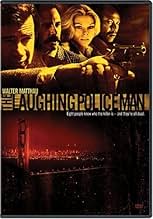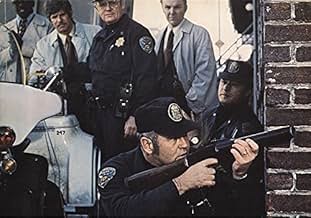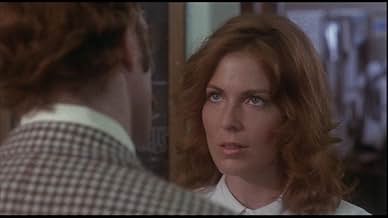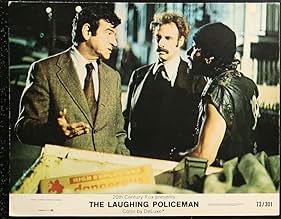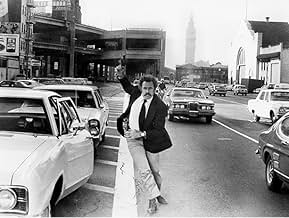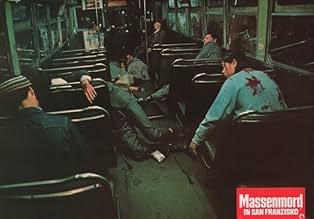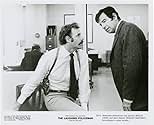AVALIAÇÃO DA IMDb
6,4/10
3,6 mil
SUA AVALIAÇÃO
Em São Francisco, Califórnia, um detetive da polícia é vítima de um assassinato em massa. Seu parceiro e um novo colega investigam o lado obscuro da cidade.Em São Francisco, Califórnia, um detetive da polícia é vítima de um assassinato em massa. Seu parceiro e um novo colega investigam o lado obscuro da cidade.Em São Francisco, Califórnia, um detetive da polícia é vítima de um assassinato em massa. Seu parceiro e um novo colega investigam o lado obscuro da cidade.
- Direção
- Roteiristas
- Artistas
Louis Gossett Jr.
- Larrimore
- (as Lou Gossett)
Don Borisenko
- Collins
- (as Jonas Wolfe)
Frances Lee McCain
- Prostitute
- (as Lee McCain)
Avaliações em destaque
Admittedly, the pace of "The Laughing Policeman" is pretty slow, but this is a well plotted murder mystery that gets a lot of juice from the marvelous chemistry between investigating detectives Walter Matthau (as Jake Martin) and Bruce Dern (as Leo Larsen). The supporting cast is likewise excellent and full of familiar faces. Producer / director / uncredited screenwriter Stuart Rosenberg makes great use of San Francisco locations, and keeps viewers intrigued with the police procedural aspect to the tale. The violence is pretty potent, and there's a certain amusement in seeing detectives Martin and Larsen work their way through the seedier environments of SF.
As the movie opens, a cop named Evans (Anthony Costello) follows a man named Niles (Louis Guss) onto a city bus; soon, a character known to Niles gets on board and pumps several passengers full of holes, including Evans and Niles. Martin, who happened to be Evans' partner, gets newly paired up with Larsen to work the case as their superior (Anthony Zerbe) demands results.
What's a joy here is seeing this cast at work. Matthau and Dern contrast nicely; what we come to know about Martin is that despite having a home and family, he's pretty much devoted to his job. Louis Gossett Jr. is fun as one of their colleagues; also making appearances are Val Avery, Cathy Lee Crosby, Mario Gallo, Joanna Cassidy, Paul Koslo, Frances Lee McCain, Clifton James, Gregory Sierra, Warren Finnerty, Matt Clark, and Wayne Grace. Albert Paulsen ("The Manchurian Candidate") has the most interesting role seeing that he actually has next to nothing in the way of dialogue.
The movie may get a little repetitive as it comes full circle at the end, but taking everything into consideration it's a good and solid example of its genre.
Based on the novel "Den Skrattande Polisen" by authors Per Wahloo & Maj Sjowall.
Seven out of 10.
As the movie opens, a cop named Evans (Anthony Costello) follows a man named Niles (Louis Guss) onto a city bus; soon, a character known to Niles gets on board and pumps several passengers full of holes, including Evans and Niles. Martin, who happened to be Evans' partner, gets newly paired up with Larsen to work the case as their superior (Anthony Zerbe) demands results.
What's a joy here is seeing this cast at work. Matthau and Dern contrast nicely; what we come to know about Martin is that despite having a home and family, he's pretty much devoted to his job. Louis Gossett Jr. is fun as one of their colleagues; also making appearances are Val Avery, Cathy Lee Crosby, Mario Gallo, Joanna Cassidy, Paul Koslo, Frances Lee McCain, Clifton James, Gregory Sierra, Warren Finnerty, Matt Clark, and Wayne Grace. Albert Paulsen ("The Manchurian Candidate") has the most interesting role seeing that he actually has next to nothing in the way of dialogue.
The movie may get a little repetitive as it comes full circle at the end, but taking everything into consideration it's a good and solid example of its genre.
Based on the novel "Den Skrattande Polisen" by authors Per Wahloo & Maj Sjowall.
Seven out of 10.
Not as bad as the other comments would suggest, "The Laughing Policeman" is a police procedural mystery that lacks the spark of great thriller genre films. What this does have is some very good acting, especially from the lead players, and a decent script with interesting characters. The plot does get a little convoluted near the end and the action is inspired by better films, but it is worth a watch. I'd give it a mild recomendation.
I've seen this movie only a few times, 4-5 throughout, I'd say. I loved how Matthau played serious in this. It's probably the only unfunny Matthau film I've seen, and this is definitely no comedy. This 70's film, with it's hard feel and vibe, is uniquely intriguing. Some nutter boards a bus, shoots down 8 people, one a police detective friend of cop, Matthau's. At the start this then alive detective was tailing some old guy, as I can remember, where obviously this has a bearing on his demise, otherwise the scene wouldn't be included in the film. What I loved, in this film, where about every exterior shot was shot in sunny weather, was the pairing of Matthau, and his new partner Dern, where he proves looks aren't everything, if you can act. Dern, playing tough here, who tends to infer violence if his suspects don't co-operate almost stole the show. One scene, has him getting into a confrontational scene with other cop, Lou Gossett Jnr, and he ever so smoothly backs down, provided a cool moment. We take the journey with Dern (who almost shared Matthau's dead partner's build, though the dead guy was better looking) and the gum chewing Matthau to find the cause of this slaughter. When questioning a pimp, as Matthau leaves, we hear a ho mumble "Pig". Matthau stops, looks around with angry intent. There's a couple of these unnerving moments from this actor's character, and it's not just in his work, though Dern came off better acting wise in this good solid crime flick, that will having you guessing why, where it's answer, will kind of thrown you into a one eighty, where you the viewer, have been really duped. We learn things about the dead cop, like how he was a bit of a creep, into things, other cops didn't know about, where some realizations start to surface. That's what makes a good crime thriller, though it doesn't have the logical of motives for the slaughter. Near it's end, if losing more faith as we do through the film to finding the killer and his reasons, our two hot shots resort to setting up this suspected killer in the same scenario as in the start. Another exhausting scene has Matthau and Dern climbing flights of steps to interrogate someone, where they stop mid flight to take a breather. Paul Koslo, again plays another loser character, who provides some info, who when questioned, has a tendency to smile all the time, and is not big on straight talk.
I just got back from San Francisco and decided to watch this again. To my surprise, I liked it much more the second time.
Make no mistake, this is not a great flick, but it is an interesting one. There are a ton of false leads in the beginning of the movie and we don't even get to the meat of the plot - the killer, for instance - until way into the running time. If you like logical and linear plots, this one will disappoint.
But there a couple of very good points. First, the ensemble cast is great. The range of characters keeps things interesting. Lou Gossett, Jr. gets a very meaty part before disappearing. Joanna Cassidy is also good in a brief role.
The highlight of the film is the relationship between Walter Matthau and Bruce Dern. Dern gets to play an early non-psycho but he is a total jerk. Yet by the end of the film you wind up liking him. Matthau is worse - he never smiles and is totally cut off from his fellow officers and his family. He can't even confront his teenage son. Watching these two make an uneasy truce and develop a relationship is what the movie really is about.
The bad news is that, except for the opening sequence, the action scenes are flat - not terrible, just flat. There are a lot of loose ends floating through the plot and characters disappear at random.
Perhaps most interesting is the parallel between this film's style and the Italian Giallo genre going on a the same time. The black gloved killer, the grim detective, even the plot holes would be right at place in an Argento movie from 1973, not a Hollywood film.
Worth two looks.
Make no mistake, this is not a great flick, but it is an interesting one. There are a ton of false leads in the beginning of the movie and we don't even get to the meat of the plot - the killer, for instance - until way into the running time. If you like logical and linear plots, this one will disappoint.
But there a couple of very good points. First, the ensemble cast is great. The range of characters keeps things interesting. Lou Gossett, Jr. gets a very meaty part before disappearing. Joanna Cassidy is also good in a brief role.
The highlight of the film is the relationship between Walter Matthau and Bruce Dern. Dern gets to play an early non-psycho but he is a total jerk. Yet by the end of the film you wind up liking him. Matthau is worse - he never smiles and is totally cut off from his fellow officers and his family. He can't even confront his teenage son. Watching these two make an uneasy truce and develop a relationship is what the movie really is about.
The bad news is that, except for the opening sequence, the action scenes are flat - not terrible, just flat. There are a lot of loose ends floating through the plot and characters disappear at random.
Perhaps most interesting is the parallel between this film's style and the Italian Giallo genre going on a the same time. The black gloved killer, the grim detective, even the plot holes would be right at place in an Argento movie from 1973, not a Hollywood film.
Worth two looks.
I saw this movie today for the Xth time. As usual, I liked it a lot. So I looked this movie up on imdb.com, to see what they had to say, and was surprised at their Summary for this movie: `Dreary, Empty-Headed Crime Drama.'
I beg to differ. I have always loved this movie. It was released in 1973. It is a perfect picture of San Francisco in the mid-70's. I was there and I recognize everything in it--people, places, and attitudes. This is the pre-AIDS, pre-Yuppie, free-wheeling, getting-used-to-it San Francisco that I loved.
The director (Jack Sommersby) has taken the usual poetic license with the locations, so that the No. 14 Mission bus miraculously goes to Chinatown, and the Transamerica Pyramid is a good view from the Transbay Bus Terminal, but never mind. Any long-time San Franciscan will recognize the sights.
Further, and even better, this is a movie of subtleties--perhaps that is why the IMDB reviewer found it dreary. We are not hit in the face with expository material. The dialogue is not used to describe what can be shown. Early in the movie, the police are confronted with a bus of dead people. Getting on the bus, nobody says `It stinks in here.' Instead, one of the policemen says to the medical examiner, who is smoking a cigar, `Blow some of that smoke over here.' And, without comment, the ME does so. That is how we know it stinks in the bus.
As the policemen look closely at the dead people on the bus, they find that one of them is a policeman. It is, in fact, Matthau's partner. But they never say to each other (and therefore to us) that this victim is a policeman. They show it only in their reactions. Someone says, `My God! It's Hansen!' or words to that effect. `What is he doing on a bus?' and other dialogue let us know that this man is a policeman.
This is a happy change from the tedious obviousness of movies that are full of lines like, `You know, Jack, you are a happy-go-lucky person. Your face shows it.' Jack sits there like the lump he is, looking neither happy nor unhappy. We have to believe the speaker, because the acting isn't going to give us this information. A good director would eliminate this line, and get some happy-face acting from Jack.
It is good to see a movie directed by someone who thinks we are smart enough to get the point without being hit over the head with it. The advice usually given to beginning writers is also good for experienced directors: Don't tell us. Show us.
The laughing policeman is Bruce Dern--new to homicide investigations, and without subtleties. He laughs a lot. Matthau is the old-timer, who never laughs. He is also not a subtle person, but he is at least cautious. They are the beagle puppy and experienced retriever of the world of murder. They are oil and water, definitely not blending.
The plot is absurd, but it hardly matters. It is the chase. It is the location. It is the ambience (dreadful, overused word, but there it is; it is the right word) that counts in this movie.
Finding it on TV is hard these days. I found it recently on Black Starz TV. Fortunately for us all, Lou Gossett, Jr. is in it, so it will show up on channels catering to African Americans. Hunt for it. It's worth it.
IMDB.com uses the 10-star rating system. Following their lead, I give it 5 stars for plot, and 9 stars for faithful depiction of a time and place.
I beg to differ. I have always loved this movie. It was released in 1973. It is a perfect picture of San Francisco in the mid-70's. I was there and I recognize everything in it--people, places, and attitudes. This is the pre-AIDS, pre-Yuppie, free-wheeling, getting-used-to-it San Francisco that I loved.
The director (Jack Sommersby) has taken the usual poetic license with the locations, so that the No. 14 Mission bus miraculously goes to Chinatown, and the Transamerica Pyramid is a good view from the Transbay Bus Terminal, but never mind. Any long-time San Franciscan will recognize the sights.
Further, and even better, this is a movie of subtleties--perhaps that is why the IMDB reviewer found it dreary. We are not hit in the face with expository material. The dialogue is not used to describe what can be shown. Early in the movie, the police are confronted with a bus of dead people. Getting on the bus, nobody says `It stinks in here.' Instead, one of the policemen says to the medical examiner, who is smoking a cigar, `Blow some of that smoke over here.' And, without comment, the ME does so. That is how we know it stinks in the bus.
As the policemen look closely at the dead people on the bus, they find that one of them is a policeman. It is, in fact, Matthau's partner. But they never say to each other (and therefore to us) that this victim is a policeman. They show it only in their reactions. Someone says, `My God! It's Hansen!' or words to that effect. `What is he doing on a bus?' and other dialogue let us know that this man is a policeman.
This is a happy change from the tedious obviousness of movies that are full of lines like, `You know, Jack, you are a happy-go-lucky person. Your face shows it.' Jack sits there like the lump he is, looking neither happy nor unhappy. We have to believe the speaker, because the acting isn't going to give us this information. A good director would eliminate this line, and get some happy-face acting from Jack.
It is good to see a movie directed by someone who thinks we are smart enough to get the point without being hit over the head with it. The advice usually given to beginning writers is also good for experienced directors: Don't tell us. Show us.
The laughing policeman is Bruce Dern--new to homicide investigations, and without subtleties. He laughs a lot. Matthau is the old-timer, who never laughs. He is also not a subtle person, but he is at least cautious. They are the beagle puppy and experienced retriever of the world of murder. They are oil and water, definitely not blending.
The plot is absurd, but it hardly matters. It is the chase. It is the location. It is the ambience (dreadful, overused word, but there it is; it is the right word) that counts in this movie.
Finding it on TV is hard these days. I found it recently on Black Starz TV. Fortunately for us all, Lou Gossett, Jr. is in it, so it will show up on channels catering to African Americans. Hunt for it. It's worth it.
IMDB.com uses the 10-star rating system. Following their lead, I give it 5 stars for plot, and 9 stars for faithful depiction of a time and place.
Você sabia?
- CuriosidadesAccording to Bruce Dern's autobiography, it was Walter Matthau's idea to have Dern, known mainly as a character actor, share top billing with him for this film, a gesture for which Dern was most grateful.
- Erros de gravaçãoThe actual gun used in the film is a Smith & Wesson M76 9mm machine gun without the barrel shroud and not an M3 .45 caliber "Grease Gun" made by GM Guide Lamp Division for WWII use. The omission of the barrel shroud gives the appearance of an M3. If one sticks to the story line, the M3 magazine held 30 rounds .45 ACP and cycled around 450 rpm. This is sufficient to inflict the damage and wounds shown in the film.
- Citações
Insp. James Larrimore SFPD: [to pimp he has just pushed to the floor] Whatever you're reaching for better be a sandwich, 'cause you're gonna have to eat it!
- ConexõesEdited into The Green Fog (2017)
Principais escolhas
Faça login para avaliar e ver a lista de recomendações personalizadas
- How long is The Laughing Policeman?Fornecido pela Alexa
Detalhes
- Data de lançamento
- País de origem
- Idioma
- Também conhecido como
- Matança em San Francisco
- Locações de filme
- 156 Robinhood Drive, San Francisco, Califórnia, EUA(Jake Martin's home)
- Empresa de produção
- Consulte mais créditos da empresa na IMDbPro
Bilheteria
- Orçamento
- US$ 2.280.000 (estimativa)
Contribua para esta página
Sugerir uma alteração ou adicionar conteúdo ausente


